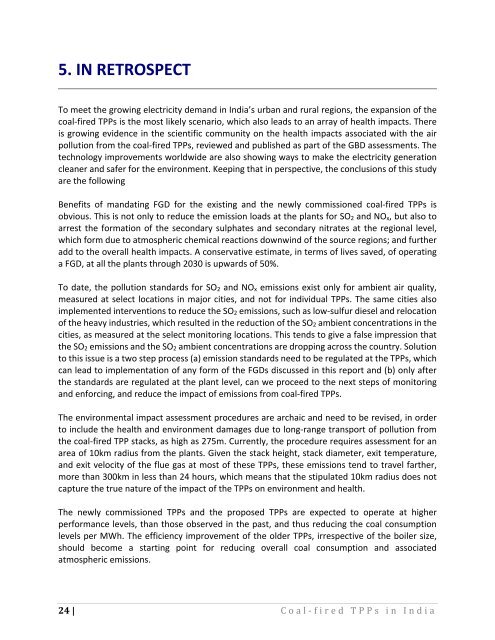Coal Kills
1TndvUf
1TndvUf
You also want an ePaper? Increase the reach of your titles
YUMPU automatically turns print PDFs into web optimized ePapers that Google loves.
5. IN RETROSPECT<br />
To meet the growing electricity demand in India’s urban and rural regions, the expansion of the<br />
coal-fired TPPs is the most likely scenario, which also leads to an array of health impacts. There<br />
is growing evidence in the scientific community on the health impacts associated with the air<br />
pollution from the coal-fired TPPs, reviewed and published as part of the GBD assessments. The<br />
technology improvements worldwide are also showing ways to make the electricity generation<br />
cleaner and safer for the environment. Keeping that in perspective, the conclusions of this study<br />
are the following<br />
Benefits of mandating FGD for the existing and the newly commissioned coal-fired TPPs is<br />
obvious. This is not only to reduce the emission loads at the plants for SO 2 and NO x , but also to<br />
arrest the formation of the secondary sulphates and secondary nitrates at the regional level,<br />
which form due to atmospheric chemical reactions downwind of the source regions; and further<br />
add to the overall health impacts. A conservative estimate, in terms of lives saved, of operating<br />
a FGD, at all the plants through 2030 is upwards of 50%.<br />
To date, the pollution standards for SO 2 and NO x emissions exist only for ambient air quality,<br />
measured at select locations in major cities, and not for individual TPPs. The same cities also<br />
implemented interventions to reduce the SO 2 emissions, such as low-sulfur diesel and relocation<br />
of the heavy industries, which resulted in the reduction of the SO 2 ambient concentrations in the<br />
cities, as measured at the select monitoring locations. This tends to give a false impression that<br />
the SO 2 emissions and the SO 2 ambient concentrations are dropping across the country. Solution<br />
to this issue is a two step process (a) emission standards need to be regulated at the TPPs, which<br />
can lead to implementation of any form of the FGDs discussed in this report and (b) only after<br />
the standards are regulated at the plant level, can we proceed to the next steps of monitoring<br />
and enforcing, and reduce the impact of emissions from coal-fired TPPs.<br />
The environmental impact assessment procedures are archaic and need to be revised, in order<br />
to include the health and environment damages due to long-range transport of pollution from<br />
the coal-fired TPP stacks, as high as 275m. Currently, the procedure requires assessment for an<br />
area of 10km radius from the plants. Given the stack height, stack diameter, exit temperature,<br />
and exit velocity of the flue gas at most of these TPPs, these emissions tend to travel farther,<br />
more than 300km in less than 24 hours, which means that the stipulated 10km radius does not<br />
capture the true nature of the impact of the TPPs on environment and health.<br />
The newly commissioned TPPs and the proposed TPPs are expected to operate at higher<br />
performance levels, than those observed in the past, and thus reducing the coal consumption<br />
levels per MWh. The efficiency improvement of the older TPPs, irrespective of the boiler size,<br />
should become a starting point for reducing overall coal consumption and associated<br />
atmospheric emissions.<br />
24 | <strong>Coal</strong>-fired TPPs in India




